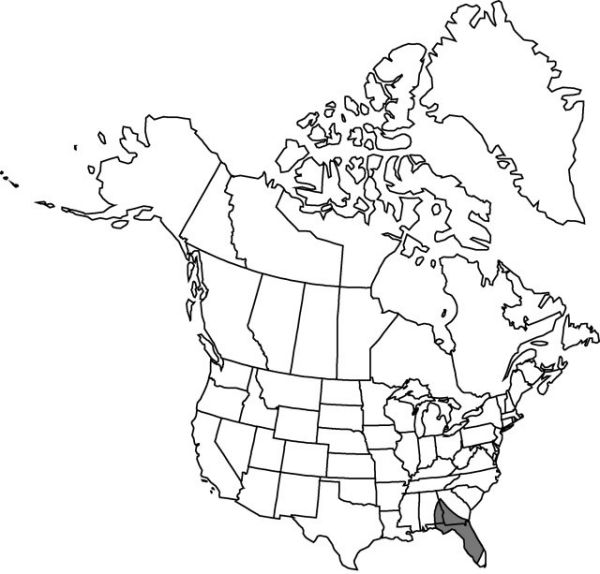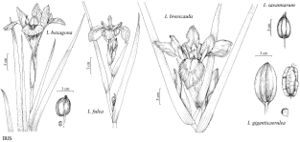Difference between revisions of "Iris savannarum"
Addisonia 9: 57, plate 317. 1925.
FNA>Volume Importer |
imported>Volume Importer |
||
| (6 intermediate revisions by 2 users not shown) | |||
| Line 8: | Line 8: | ||
}} | }} | ||
|common_names=Prairie iris | |common_names=Prairie iris | ||
| + | |special_status={{Treatment/ID/Special_status | ||
| + | |code=F | ||
| + | |label=Illustrated | ||
| + | }}{{Treatment/ID/Special_status | ||
| + | |code=E | ||
| + | |label=Endemic | ||
| + | }} | ||
|basionyms= | |basionyms= | ||
|synonyms={{Treatment/ID/Synonym | |synonyms={{Treatment/ID/Synonym | ||
|name=Iris albispiritus | |name=Iris albispiritus | ||
|authority=Small | |authority=Small | ||
| − | }}{{Treatment/ID/Synonym | + | |rank=species |
| + | }} {{Treatment/ID/Synonym | ||
|name=Iris hexagona var. savannarum | |name=Iris hexagona var. savannarum | ||
|authority=(Small) R. C. Foster | |authority=(Small) R. C. Foster | ||
| − | }}{{Treatment/ID/Synonym | + | |rank=variety |
| + | }} {{Treatment/ID/Synonym | ||
|name=Iris kimballiae | |name=Iris kimballiae | ||
|authority=Small | |authority=Small | ||
| − | }}{{Treatment/ID/Synonym | + | |rank=species |
| + | }} {{Treatment/ID/Synonym | ||
|name=Iris rivularis | |name=Iris rivularis | ||
|authority=Small | |authority=Small | ||
| + | |rank=species | ||
}} | }} | ||
|hierarchy=Iridaceae;Iris;Iris subg. Limniris;Iris sect. Limniris;Iris (sect. Limniris) ser. Hexagonae;Iris savannarum | |hierarchy=Iridaceae;Iris;Iris subg. Limniris;Iris sect. Limniris;Iris (sect. Limniris) ser. Hexagonae;Iris savannarum | ||
| Line 35: | Line 46: | ||
|habitat=Wet ditches, margins of lakes, streams, and swamps | |habitat=Wet ditches, margins of lakes, streams, and swamps | ||
|distribution=Ala.;Fla.;Ga. | |distribution=Ala.;Fla.;Ga. | ||
| − | |discussion=<p>Iris savannarum has often been included in I. hexagona, but differs in several ways. The capsules of I. hexagona are more obviously hexagonal, with smooth faces alternating with those that have two rounded lobes, whereas the capsules of I. savannarum are more rounded but with six obvious ridges, almost of winglike proportions. Iris hexagona has yellow-green leaves instead of the brighter green of I. savannarum. The leaves of I. savannarum die back after anthesis, while those of I. hexagona remain green. The flowering period of I. savannarum is almost one month earlier than that of I. hexagona in the area where both are known to grow. The sepals of I. savannarum are more acute at the apex than those of I. hexagona.</p><!-- | + | |discussion=<p><i>Iris savannarum</i> has often been included in <i>I. hexagona</i>, but differs in several ways. The capsules of <i>I. hexagona</i> are more obviously hexagonal, with smooth faces alternating with those that have two rounded lobes, whereas the capsules of <i>I. savannarum</i> are more rounded but with six obvious ridges, almost of winglike proportions. <i>Iris hexagona</i> has yellow-green leaves instead of the brighter green of <i>I. savannarum</i>. The leaves of <i>I. savannarum</i> die back after anthesis, while those of <i>I. hexagona</i> remain green. The flowering period of <i>I. savannarum</i> is almost one month earlier than that of <i>I. hexagona</i> in the area where both are known to grow. The sepals of <i>I. savannarum</i> are more acute at the apex than those of <i>I. hexagona</i>.</p><!-- |
| − | --><p>Iris savannarum has been hybridized with Iris fulva to produce I. ×cacique (J. Berry) N. C. Henderson.</p> | + | --><p><i>Iris savannarum</i> has been hybridized with <i>Iris fulva</i> to produce I. ×cacique (J. Berry) N. C. Henderson.</p> |
|tables= | |tables= | ||
|references= | |references= | ||
| Line 45: | Line 56: | ||
-->{{#Taxon: | -->{{#Taxon: | ||
name=Iris savannarum | name=Iris savannarum | ||
| − | |||
|authority=Small | |authority=Small | ||
|rank=species | |rank=species | ||
| Line 58: | Line 68: | ||
|publication title=Addisonia | |publication title=Addisonia | ||
|publication year=1925 | |publication year=1925 | ||
| − | |special status= | + | |special status=Illustrated;Endemic |
| − | |source xml=https:// | + | |source xml=https://bitbucket.org/aafc-mbb/fna-data-curation/src/2e0870ddd59836b60bcf96646a41e87ea5a5943a/coarse_grained_fna_xml/V26/V26_805.xml |
|genus=Iris | |genus=Iris | ||
|subgenus=Iris subg. Limniris | |subgenus=Iris subg. Limniris | ||
Latest revision as of 22:17, 5 November 2020
Rhizomes greenish, freely branching, forming large, open clumps, 2–2.5 cm diam., fleshy, with fibrous bases of old leaves not covering rhizome but persisting on ringlike scars. Stems 1-branched, solid, 3–10 dm. Leaves: basal usually dying back shortly after anthesis, blade bright green, 6–10 dm × 0.8–2 cm, sometimes glaucescent; cauline with blade elongate, linear-attenuate, 15–20 cm, exceeding flowers. Inflorescence units 1–3-flowered, branch units 1–2-flowered; spathes lanceolate, subequal or unequal, apex acute; outer 8–10 cm, herbaceous, margins scarious; inner 6–9 cm, completely scarious. Flowers: perianth blue to blue-violet (white in forma albispiritis); floral tube funnelform, 1.2–1.5 cm; sepals blue or pale violet with flecks of white and lines of deeper blue on either side of ridge, spatulate, elliptic to ovate, 7–8 cm, apex acuminate, ridge yellow, linear, extending to about middle of limb, finely pubescent, claw light green, striated, ribbed, 1–1.2 cm; petals erect or spreading-erect, deep blue, linear to narrowly linear-spatulate, 6–7.5 cm, base abruptly attenuate into claw, claw channeled, green with darker lines, margins pale; ovary bluntly 3-angled, ridged at each angle and on faces between angles; style linear-acute, 5–6 cm; crests ovate, 1–2 cm, margins sharply and irregularly toothed; stigmas broadly 2-lobed, margins crenate; pedicel 1.6–2 cm. Capsules ellipsoid, round in cross section, roundly 6-lobed, with 6 sharp, winglike, equally spaced ridges converging to form stout beak at apex, 6–10 cm, dehiscence loculicidal. Seeds in 1 row per locule, brown, circular or uneven, flattened, 8–12 mm diam, very corky. 2n = 44.
Phenology: Flowering late Mar–early Apr.
Habitat: Wet ditches, margins of lakes, streams, and swamps
Distribution

Ala., Fla., Ga.
Discussion
Iris savannarum has often been included in I. hexagona, but differs in several ways. The capsules of I. hexagona are more obviously hexagonal, with smooth faces alternating with those that have two rounded lobes, whereas the capsules of I. savannarum are more rounded but with six obvious ridges, almost of winglike proportions. Iris hexagona has yellow-green leaves instead of the brighter green of I. savannarum. The leaves of I. savannarum die back after anthesis, while those of I. hexagona remain green. The flowering period of I. savannarum is almost one month earlier than that of I. hexagona in the area where both are known to grow. The sepals of I. savannarum are more acute at the apex than those of I. hexagona.
Iris savannarum has been hybridized with Iris fulva to produce I. ×cacique (J. Berry) N. C. Henderson.
Selected References
None.
